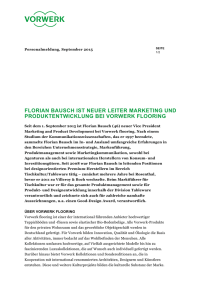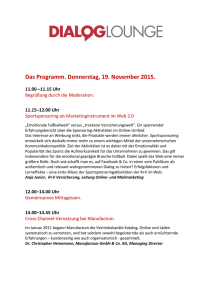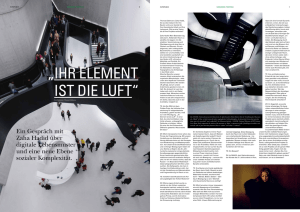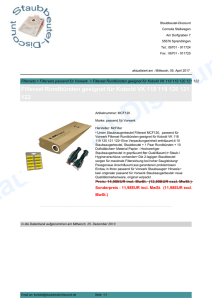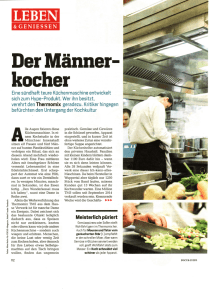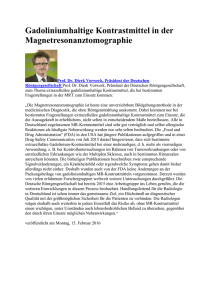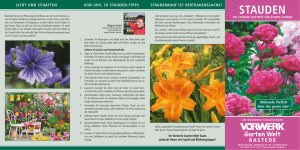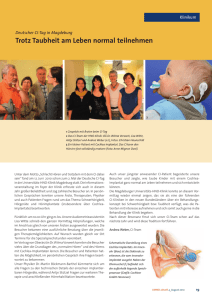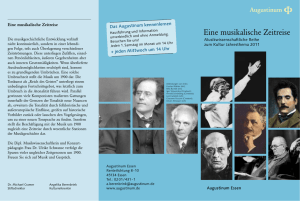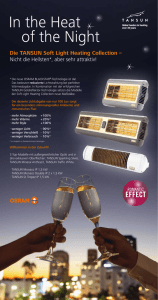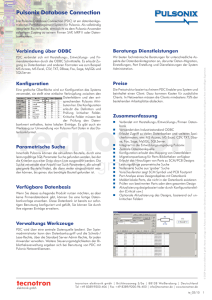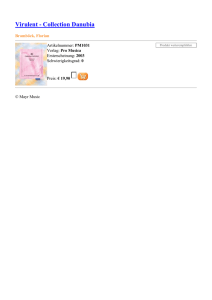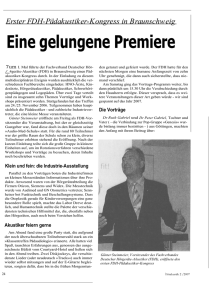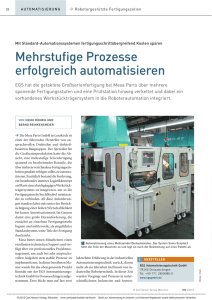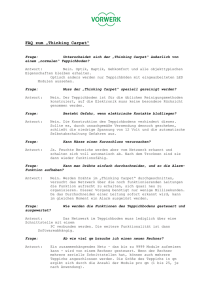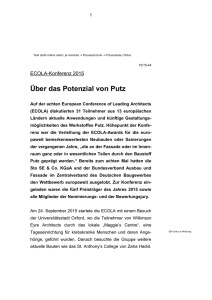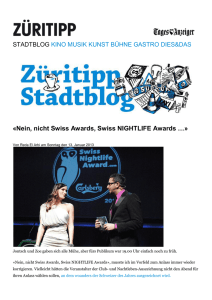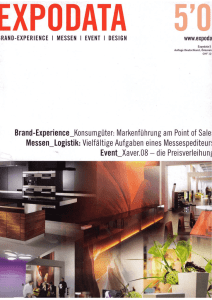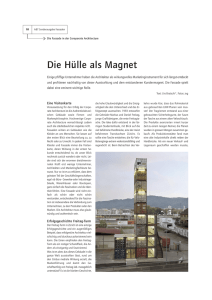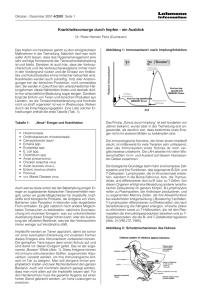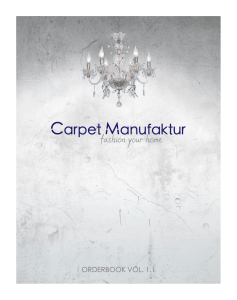über BODENARCHITEKTUR
Werbung
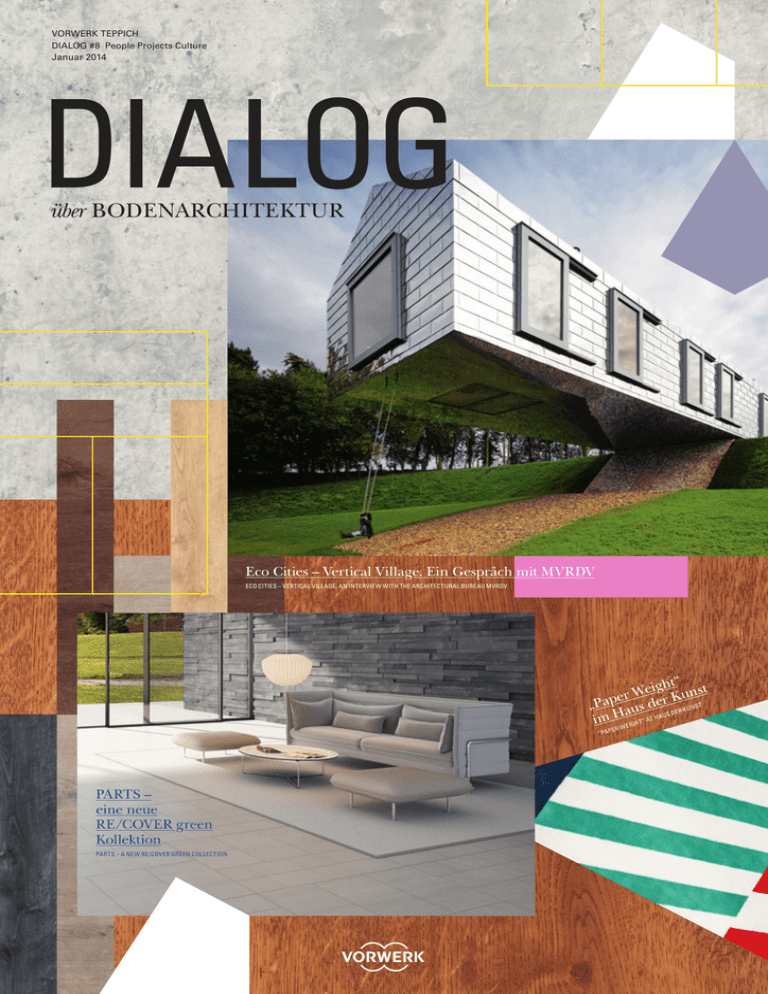
VORWERK TEPPICH DIALOG #8 People Projects Culture Januar 2014 DIALOG über BODENARCHITEKTUR Eco Cities – Vertical Village. Ein Gespräch mit MVRDV ECO CITIES – VERTICAL VILLAGE. AN INTERVIEW WITH THE ARCHITECTURAL BUREAU MVRDV ight“ nst e W er Ku „Pap aus der DER KUNST S im H EIGHT” AT HAU “ PA PARTS – eine neue RE/COVER green Kollektion PARTS – A NEW RE/COVER GREEN COLLECTION PER W 2 01 NEW COLLECTION S. 04 PARTS – Teile der Natur P. 04 PARTS – PARTS OF NATURE 02 ART COLLECTION S. 08 Die Ausstellung „Paper Weight“ im Haus der Kunst P. 08 THE EXHIBITION “PAPER WEIGHT” AT HAUS DER KUNST 03 INTERVIEW S. 10 Eco Cities – Vertical Village. Ein Gespräch mit MVRDV P. 10 ECO CITIES – VERTICAL VILLAGE. AN INTERVIEW WITH MVRDV 04 REFERENZ S. 14 Die Seniorenresidenz Augustinum P. 14 THE AUGUSTINUM SENIOR CITIZENS’ RESIDENCE 05 MESSE S. 16 Vorwerk auf der EuroShop 2014 032c und Roy Lichtenstein im Haus der Kunst / 032c and Roy Lichtenstein in “Haus der Kunst” P. 16 VORWERK AT EUROSHOP 2014 EDITORIAL VORWERK TEPPICH 33 Extrem nachhaltig, extrem sozial, konsequent: MVRDVs „The Pushed Slab“ in Paris ist kein ganz normales Bürogebäude / Extremely sustainable, extremely social-minded, consistent: MVRDV’s “Pushed Slab” in Paris is no normal office building. Parkettierungen der Nachhaltigkeit SUSTAINABILITY TILINGS Vor einem Jahr haben wir an dieser Stelle RE/COVER green vorgestellt, unsere neue Generation elastischer Bodenbeläge, die überwiegend aus nachwachsenden Rohstoffen besteht. Mit dieser Vorwerk Innovation, die ökologische mit ästhetischen und funktionalen Ansprüchen optimal verbindet, lagen wir genau richtig. Die erste RE/COVER green Kollektion UNI/PRINT kam so gut an, dass wir nun, mit dieser 8. Ausgabe der Dialog die zweite Kollektion erstmals präsentieren. Sie nennt sich PARTS (Seite 04). Wieder hat der renommierte Architekt Hadi Teherani sein Wissen eingebracht, um mit PARTS eine Parkettierung zu schaffen, mit der Architekten und Designer bestens gestalten können. Aus Natur und Umwelt abstrahierte Strukturen und Oberflächen sind hier das ästhetische Thema, um im Interior den Boden in eine natürlich anmutende Welt zu verwandeln. Einen anderen und gleichzeitig ähnlichen Blick auf Bodenarchitektur wirft die niederländische Architektin Nathalie de Vries in einem Interview (Seite 10). Wir freuen uns ganz besonders, dass die Mitbegründerin von MVRDV, einem der derzeit wohl international angesagtesten, radikalsten Architekturbüros und Vorreiter im Green Building, Einblicke in ihre Denk- und Arbeitsweisen gibt. Sie sagt: „Ökonomie ist auch Ökologie“ – ein spannender Standpunkt. Nicht nur Technik und Ressourceneffizienz, auch die Einbeziehung von Kontext und Mensch in urbane Planungen sind ein weiterer Aspekt der Nachhaltigkeitsphilosophie von MVRDV: nämlich Räume und Orte so zu gestalten, dass sie bedeutsam für Menschen werden, damit sie sich dauerhaft wohlfühlen können, egal, wie sich ihr Leben verändert. Nur so vermeiden wir langfristig unnötigen Architekturmüll. Und genau darum geht es Vorwerk ja auch, in einem anderen Maßstab natürlich, wenn wir Konzepte für Bodenbeläge entwickeln. Und wozu das führen kann, präsentieren wir in einem weiteren Beitrag über die Bodenarchitektur in der Seniorenresidenz Augustinum in Freiburg (Seite 14). Hier hat sich nämlich gezeigt, wie allein eine gute Bodenarchitektur zum Wohlbefinden der Menschen beitragen kann. Eine besondere Auswahl an Mustern und Farben schafft nicht nur Orientierung, sondern macht lange Wege auf Fluren gefühlt kürzer, was für Menschen mit Gehbehinderungen eine Wohltat ist. „Idealismus ist ein Schlüsselbegriff“, sagt Felix Burrichter, Herausgeber und Creative Director des in New York ansässigen Architektur-Magazins „PIN-UP“, zwar über das Herausgeben und Machen von Zeitschriften (Seite 08). Wenn man sich aber die Beiträge der Dialog 8 durchliest, stellt man fest, dass dieser Satz genau das ist, was alle hier vorgestellten, noch so unterschiedlichen Projekte miteinander verbindet. Ohne Idealismus ließen sich großartige Dinge nicht bewegen. Lassen auch Sie sich inspirieren! Viel Freude beim Lesen wünscht A year ago we took the occasion to introduce RE/COVER green here, our new generation of elastic floorings comprised predominantly of renewable raw materials. We were ‘spot on’ with this Vorwerk innovation that optimally combines ecological, aesthetic and functional demands. The RE/COVER green collection UNI/PRINT was received so well that we are now presenting the second collection, PARTS, in this issue of DIALOG 8 (page 04). Renowned architect Hadi Teherani has once again brought his expertise to bear to create a tiling with which architects and designers can design at their best; we’ve termed it PARTS. Structures and surfaces abstracted from nature form the aesthetic theme here to transform the floor in an interior into a world with a natural look. A simultaneously similar look at floor architecture from a different angle is taken by Dutch architect Nathalie de Vries in an interview (page 10). We are particularly pleased that the co-founder of MVRDV, one of the currently and internationally most sought-after, most radical architectural bureaus and a pioneer in the field of Green Building, offers insights into her ways of thinking and working. She says “economy is ecology, too” – an intriguing standpoint. Not based solely on technology and resource efficiency, the inclusion of context and the human being in urban planning poses another aspect of the sustainability philosophy held by MVRDV: to design spaces and sites in such a way that they become meaningful to people, so that they can feel good on a lasting basis, regardless of how their lives change. The only way for us to prevent unnecessary architectural ‘trash’ in the long run. Though naturally on a different scale, that’s exactly what it’s all about at Vorwerk too when we develop concepts for floor coverings. And we are presenting where that can lead to in another feature about the floor architecture at the Augustinum in Freiburg, Germany, a home for senior citizens (page 14). What has been demonstrated here is how a good floor architecture alone can contribute to people’s well-being. A special selection of patterns and colours not only creates a sense of orientation: long walkways along corridors are felt to be shorter, a ‘blessing’ for people with handicapped mobility. “Idealism is a key concept,” says Felix Burrichter, publisher and creative director of the New York-based architectural magazine “PIN-UP”, when referring to the publication and making of periodicals (page 08). Yet in the course of reading through the articles in DIALOG 8 one realises that this phrase is precisely what links all the projects presented here with one another, as different as they are. Without idealism, great things just couldn’t get going. Let yourself be equally inspired! Wishing you lots of reading pleasure, Ihr Johannes Schulte, Geschäftsführer Vorwerk Teppichwerke Johannes Schulte President & CEO Vorwerk Teppichwerke RUBRIK R RU NEW UBRIK BR RCOLLECTION IK K VORWERK TEPPICH 4 RUBRIK RU R NEW UBR RCOLLECTION IK IK VORWERK TEPPICH 5 Mit RE/COVER green – the new organic flooring – präsentierte Vorwerk erstmals eine neue Generation elastischer Bodenbeläge für den Objektbereich. Für das Design der ersten Kollektion, UNI/ PRINT, zeichnete das renommierte Architekturbüro Hadi Teherani verantwortlich. Die neue Kollektion PARTS führt den ökologischen und designorientierten Ansatz von RE/COVER green konsequent fort. PARTS ist in drei verschiedenen Dimensionen erhältlich, welche eine Kombination verschiedener Farben und Dekore ermöglichen. Die Texturen interpretieren Materialien aus Natur und Umwelt in verschiedenen Abstraktionsgraden. Eine strukturierte Oberfläche überlagert die jeweiligen Dekore und verleiht dem Produkt Natürlichkeit und Tiefe. Der Bodenbelag wird so zu einem lebendigen Teil der Architektur. Alle Holzdekore sind als Dielenformat erhältlich, das wie Parkett in verschiedenen Verbänden verlegt werden kann. In größeren Platten-Formaten sind die von Naturstein und Sichtbeton inspirierten Dekore wie MOON und POUR verfügbar. Die Farbgebung der neuen PARTS knüpft an die vorhandenen, TEILE DER NATUR Nach UNI/PRINT kommt nun die PARTS – die zweite RE/COVER green Kollektion, die überwiegend aus nachwachsenden Rohstoffen hergestellt wird. VORWERK TEPPICH NEW COLLECTION sanften und vielseitig einsetzbaren Paletten in Grau und Beige an, stellt jedoch auch neue, kräftigere Farben vor, wie Cognac-, Blau- und Violetttöne. Die PARTS-Planken werden mit dem Untergrund verklebt. Die herausragende Belastbarkeit und Langlebigkeit macht PARTS zu einem idealen Produkt für die verschiedenen Einsatzzwecke im Objektbereich, wie etwa Hotels, Shops, Messestände und Restaurants. Aber auch im gehobenen Wohnbereich verwandeln die PARTS den Boden in eine beeindruckend natürliche Welt. PARTS OF NATURE AFTER UNI/PRINT, NOW PARTS ARE COMING – THE SECOND RE/COVER GREEN COLLECTION PREDOMINANTLY MANUFACTURED FROM RENEWABLE RAW MATERIALS. RE/COVER green – the new organic flooring – was the first time that Vorwerk presented a new generation of elastic floorings for the businesssite sector. The renowned architectural bureau Hadi Teherani was in charge of designing the first collection, UNI/PRINT. The new PARTS collection consistently sets forth the ecological and designoriented approach displayed in RE/COVER green. PARTS is available in three different sizes and allows colours and decors to be combined. The textures interpret materials from nature and the environment in differ- 6 NEW COLLECTION VORWERK TEPPICH 7 USED greyish brown P 020 USED dark brown P 021 USED dark shade P 022 MARK light nature P 026 MARK cognac blond P 027 MARK dark brown P 028 PEARL light nature P 034 PEARL silver P 035 PEARL dark brown P 033 ROUGH dark brown P 024 ROUGH dark shade P 025 LINE whitewash P 030 LINE greyish brown P 031 LINE dark shade P 032 FINE whitewash P 036 FINE light nature P 037 MOON dark brown P 049 MOON silver P 050 MOON sand P 048 POUR arctic night P 044 POUR warm grey P 046 POUR sand P 045 POUR whitewash P 047 ROPE black P 043 ROPE blue night P 039 ROPE violet P 040 ROPE warm grey P 041 USED warm grey P 019 ROUGH light nature P 023 PARTS – A collection overview You can find more information about PARTS on the internet at www.vorwerk-carpet.com ent degrees of abstraction. A structured surface overlays the respective decors and lends the product naturalness and depth. As a result the flooring becomes a lifelike part of the architecture itself. All of the wood decors are purchasable as a floorboard format that can be laid like parquet in different joining patterns. Decors such as MOON and POUR inspired by natural stone and ornamental concrete are available in larger slab formats. The colour scheme of the new PARTS collection takes up the existing soft and diversely deployable ranges MARK blue night P 029 FINE cognac blond P 038 ROPE whitewash P 042 in grey and beige, yet it also introduces new and more striking hues in shades of cognac, blue and violet. The PARTS planks are glued to the subflooring. Outstanding, durable resilience and longevity make PARTS an ideal product for the widest variety of areas of use in the business-site sector, for instance hotels, shops, tradefair booths and restaurants. Although, in the upmarket home-living sector PARTS equally transform the floor into an impressively natural world, too. ART COLLECTION VORWERK TEPPICH Die Ausstellung „Paper Weight. Stilbildende Magazine von 2000 bis heute“ ermöglichte vom 12. Juli – 27. Oktober 2013 einen frischen Blick auf unabhängiges Publizieren im 21. Jahrhundert. Kernstück der Präsentation im Haus der Kunst in München waren 15 Magazine, die seit dem Jahr 2000 gegründet wurden – jedes von ihnen stilbildend und unabhängig, d. h. keines gehört einer großen Verlagsgruppe an. Vorwerk unterstützte die Ausstellung mit einer Spezialanfertigung des Roy-LichtensteinTeppichs aus der Art Collection. Das auffällig gemusterte Modell inszeniert den Schattenwurf einer überdimensional großen, aufgeschlagenen Ausgabe des zeitgenössischen Kulturmagazins 032c. Herausgeber und Chefredakteur Jörg Koch wählte den Teppich des Pop-ArtKünstlers, da sein unverwechselbarer Stil das progressive Konzept von 032c untermalt. Zudem bringt die Installation den avantgardistischen Anspruch des Magazins mit dem innovativen, künstlerischen Geist von Vorwerk Teppich zusammen. PAPER WEIGHT – 032C AND ROY LICHTENSTEIN AT HAUS DER KUNST From July 12th – October 27th 2013 the exhibition “Paper Weight. Genredefining Magazines 2000 to Now” made it possible to take a fresh look at independent publishing in the 21st century. The centrepiece of the 8 presentation at the Haus der Kunst museum in Munich was formed by 15 magazines that had been founded since 2000 – each of them genredefining and independent, i. e. none belongs to a major publishing group. Vorwerk supported the exhibition with a specially produced version of the Roy Lichtenstein carpet from its Art Collection. The remarkably patterned model stages a shadowed version of an oversized, flipped-open issue of the contemporary culture magazine “032c”. Jörg Koch, publisher and editor-in-chief, chose the carpet by the Pop Art artist because its unmistakeable style underscores the progressive concept behind “032c”. In addition, the installation merges the avant-garde standard the magazine sets for itself with the innovative and artistically creative approach taken by Vorwerk Carpets. PAPER WEIGHT – 032C UND ROY LICHTENSTEIN IM HAUS DER KUNST ART COLLECTION VORWERK TEPPICH , ist t e d n ü r g g a z in a M n i e ist s e t u u m e s i h l r a e e „W t. (...) Id s i m i t p O ft sind o d n u , f f per se ein i lbegr e s s ü l h c S eines n e b a daher ein g s u ten A s r e e i d m vor alle ifest.“ n a M t r A r eine ve Directo und Creati r e b e M a g a z i ns sg u era ng sow ie H sstellu „PIN -UP “ tor der Au ra u K r, Magazins te rh tu ic k e rr it u h B Felix igen A rc York ansäss des in New 9 INTERVIEW VORWERK TEPPICH 10 ECO CITIES – VERTICAL VILLAGE MVRDV: Architektur für ein. besseres, individuelles und. kollektives Leben in der Stadt. Seit Ihrem niederländischen Pavillon auf der Expo 2000 Hannover, einem Laborhaus aus gestapelten Landschaften und Nutzgärten, gehört MVRDV zu den Vordenkern nachhaltiger Architektur. Gefällt Ihnen dieses Image? Nathalie de Vries: Ja, aber ich sehe es eher als temporäres Prädikat. In naher Zukunft sollte es ganz normal für Architekten sein, sich damit zu beschäftigen. MVRDV hat mit diesem Pavillon ein Statement gesetzt und Lösungen für einen besseren Umgang mit der Ressource Raum und Platz geschaffen. Wir leben in einem Zeitalter, wo es immer mehr Menschen gibt, die in Städten leben werden. Diese Menschen möchten alle ein gutes Leben haben, sie müssen ernährt werden. Der Pavillon zeigte, dass nicht nur Wohnungen und Büros gestapelt werden können, sondern eben auch Landschaften und Gärten. Er zeigte, dass man anders mit Dichte umgehen kann. Verdichtung durch Mischung von Funktionen, effektiver Aufbau von Städten, um Raum zu sparen, die Landwirtschaft in die Stadt hineinzubringen, Ökosysteme zu bauen, Nachbarschaften als Energieproduzenten zu sehen, diese Themen haben wir mit dem Pavillon angestoßen. Sie sind in vielen unserer Projekte auch aktuell zu sehen. Dinge, mit denen sich jeder beschäftigen sollte. MVRDV ist bekannt für radikale Recherchemethoden: Oft werden für Designprozesse riesige Mengen komplexer Daten untersucht und verarbeitet, um zu einem progressiven Idealbild einer urbanen Zukunft zu gelangen. Können Sie das anhand eines Beispiels erklären? NdV: Für uns ist Kontext mehr als Einbeziehung des Ortes, an dem wir bauen. Deshalb ist es wichtig, Informationen über Benutzung und Verhaltensweisen zu integrieren. Wie bringen wir Nahrung/ Landwirtschaft dichter an die Leute heran und bilden daraus eine Stadt der Zukunft, die eher wie eine Landschaft aussieht als eine Ansammlung von Gebäuden? Stichwort interaktiver Städtebau, Vertical Village: Mittlerweile sind wir so weit, dass wir die Daten umsetzen können in Software, mit der die Bewohner selbst eigene Städte zusammenstellen. So kann man Vielschichtigkeit schaffen und Raum für individuelle Wünsche gestalten. Oft entwerfen wir lediglich einen architektonischen Rahmen, in den Individuen sich einfügen können. Ein Beispiel: Vor dem Bau der Sendezentrale des niederländischen Fernsehsenders VPRO haben wir ausgiebig mit den zukünftigen Nutzern über die Qualitäten ihrer Arbeitsplätze gesprochen. Manche wollten an offenen Türen zum Garten arbeiten, andere im Dunkeln, andere unter einer Dachbodenschräge. Der niederländische Pavillon für die Expo 2000 in Hannover / Landscape and garden thought differently: Things are stacked at the Netherlands pavilion for Expo 2000 in Hanover Wir haben alle Wünsche dann zusammengebracht in einem Gebäude. Lösungen für Social Housing sind ein großes Thema Ihrer Arbeit. Was sind dabei die größten Herausforderungen für die Zukunft? NdV: Das Wegkommen von Uniformisierung, von Massenbauten. Wie ist mit geringen Budgets individuelle Gestaltung möglich, so dass sich Häuser und Wohnungen leichter an Veränderungen im Leben der Bewohner anpassen lassen? Eine weitere Herausforderung: das gleichzeitige Schaffen von Öffent- lichkeit und Individualisierung. Egal wo, die Menschen haben letztendlich dieselben Bedürfnisse nur unter anderen Konditionen. Eins Ihrer aktuellen Projekte ist das Bürogebäude „The Pushed Slab“. Es soll ¼ der Energie vergleichbarer Gebäude verbrauchen. Was macht es so energieeffizient? NdV: Es gibt viele Elemente, die hier komplex zusammenwirken: spezielle Materialien wie z. B. FSC zertifiziertes Holz aus Frankreich als Fassadenverkleidung, natürliche Belüftung, kluge RUBRIK INTERVIEW VORWERK TEPPICH 11 Ungewohntes Wohnen in „The Balancing Barn“: schwebender Hausbalken mit Bodenfenster statt Teppich / Out-of-the-ordinary living in the “Balancing Barn”: Floating house beams with a floor window instead of a carpet keit zu tun, sondern mit Kontext, mit Städtebau. Und damit wird das Gebäude auch besser akzeptiert. Interessant ist natürlich, dass diese Aktivität des „Pushens“ auch innen wie außen wieder spannende Raumsituationen schafft. In der Basis haben viele unserer Gebäude eine einfache Typologie, aber durch die Bearbeitung, die Intensivierung und Zusammenlegung von gewissen Nutzungen entsteht etwas völlig Neues: Räume, die sowohl mit der Stadt kommunizieren als auch im Gebäude für die Menschen Orte der Kommunikation bilden. Das Gebäude wird zum Bindeglied zwischen Stadt und Mensch. Gebäudesysteme, Solarpanels, außenliegende Dämmung sowie die Einbindung eines Grauwasser-Recyclingsystems. Wie kam es zur ungewöhnlichen Form? NdV: Die Anwohner, die hinter diesem Gebäude wohnen, wollten gerne einen Ausblick haben und nicht nur auf ein Bürogebäude schauen. So kamen wir auf die Idee, das Gebäude in der Mitte förmlich durchzudrücken. Es ist eine Öffnung entstanden. Jetzt können Anwohner durch das Bürohaus hindurchgucken. Das hat nichts mit Nachhaltig- In Ihrer Designphilosophie sprechen Sie von „wahrer Nachhaltigkeit“ bezogen auf ein soziales, philosophisches Level. Was bedeutet das? NdV: Um gute Gebäude, Orte, Städte zu schaffen, sind nicht nur Technik oder perfekte Konstruktion wichtig. Es geht auch um die Wirkung aus der Perspektive der Anwohner. Wie nutzen oder möchten die Leute eine Stadt nutzen? Wie kann man eine Bereicherung für das städtische Leben und gleichzeitig das Individualleben schaffen? Man braucht kollektive Gebäude und Räume, die mehr sind als pure Funktion. Überall auf der Welt wurden zu viele Häuser gebaut, die nun als eine Art architektonischer Müll leer stehen, weil sie eine gewisse Lieblosigkeit haben, zwecklos und öde geworden sind. Keiner möchte mehr darin leben oder arbeiten. Sie sind vielleicht technisch phantastisch konstruiert, aber wenn keiner sie mag, ist das nicht nachhaltig. Sie haben einmal gesagt, dass es bei Nachhaltigkeit nicht immer darum geht, sich einzuschränken. Was meinen Sie damit? NdV: Ökonomie ist auch Ökologie. Wir können natürlich die Dinge so machen, dass wir wenig Material, Energie usw. benutzen. Aber wenn man zum Beispiel seine eigene Energie erzeugt, bekommt man eine ganz andere Bilanz: Es geht eher darum, wie Kreisläufe wieder geschlossen werden. Man kann das Licht ausmachen, man kann aber auch sein mit eigener Energie erzeugtes Licht brennen lassen. Anders gesagt: Anstatt immer dickere Dämmungsschichten auf Gebäude anzubringen, also immer mehr Material hinzuzufügen, könnte man Alternativen entwickeln. Es geht um Bilanzen. Wir werden immer schlauer im Recyclen. Für die Zukunft könnte ich mir vorstellen, dass wir Gebäude, Teile abbrechen und wieder neu aufbauen oder ständig ändern können. Anstatt zu sagen: Alles muss für die Ewigkeit drei Meter dick sein. Da müssen wir andere Lösungen finden und unsere Erwartungshaltung ändern. In Holland gibt es jetzt eine Firma, die Teppiche least. Möchte der Kunde den Teppich nach ein paar Jahren nicht mehr, nimmt die Firma den Teppich wieder zurück. Und recyclet ihn. Normalerweise werden Teppiche alle zehn Jahre weggeschmissen. Es müsste auch Möbelsysteme geben, die man unendlich wiederverwenden kann. Das sind doch die interessanten Gedanken! Entweder man gestaltet die Dinge flexibler oder man bietet durch innovativen Service mehr Spielraum zur Nutzung. Wir merken, dass alles, was in einem starren, standardisierten Format endet, nicht gut ist. Egal ob Büro oder Wohnung. Gibt es einen ästhetischen Code in der Architektur, der Nachhaltigkeit kommuniziert? NdV: Nein. Wir haben gerade den Auftrag erhalten, ein extrem nachhaltiges Gebäude zu bauen. Wir haben gesagt, die große Herausforderung wäre, es so zu bauen, dass man seine Nachhaltigkeit gar nicht sieht. Man kann nur messen, dass es nachhaltig ist. Unser Auftraggeber sagte, ok, es wäre doch lustig, wenn man dann irgendwo einfach nur ein Messgerät aufhängen würde. Die Konstruktion der „Balancing Barn“, eines länglichen Hauses in Großbritannien, das auf einen Hügel gebaut ist, mutet sehr waghalsig an: denn eine Seite schwebt in der Luft. Dort ist das INTERVIEW Wohnzimmer untergebracht mit einem großen Bodenfenster. Welche Rolle spielt Bodenarchitektur in Ihren Arbeiten? NdV: In unserer Architektur ist der Boden eine weitere Dimension, genauso wichtig wie Wände und andere Flächen. Wenn man anfängt, Räume unter dem Boden zu schaffen und Ebenen übereinander zu lagern, dann ist der Boden für MVRDV eher eine Schicht, ein Raumtrenner. Es gibt aber keine Hierarchie. Er ist genauso Fassade, Hülle wie alles andere. Im Fall der „Balancing Barn“ ist der Boden ein Fenster geworden. Verstehen Sie die Gestaltung von Interior also als logische Konsequenz Ihrer Architektur? NdV: Ja, ich denke, dass wir immer mit Raumgestaltung beschäftigt sind. Bei MVRDV sind Boden, Wand und Dach oft in derselben Farbe, ja sogar aus dem selben Material. Wir sehen den Boden innen als Fortsetzung des Bodens außen. Teppiche haben wir als Architekturelement in einem unserer ersten Projekte eingesetzt, der Villa VPRO. Dort haben wir Teppiche benutzt, um das Wohnen ins Arbeiten überfließen zu lassen – damals war das noch neu. Vielleicht ist es auch ganz interessant, dass wir öfter Materialien, die eigentlich für den Boden gemacht sind, für Wände oder Dach benutzen. Weil wir Materialien eher als Hülle oder als Oberfläche sehen, die eine gewisse Funktion haben. Wir lassen die Unterschiede gerne los. Also, wenn Sie mal einen Teppich finden, den man auch als Fassade benutzen kann ...? Mit Grasteppichen geht das. Wir müssen vielleicht dahin, Materialien entsprechend ihrer Eigenschaften zu benutzen, dann ist es egal, wofür. VORWERK TEPPICH MVRDV made a statement with that pavilion and created solutions for dealing better with space and room as a resource. We live in an age where there are more and more people who are going to be living in cities. All of these people want to have a good life; they have to be fed. The pavilion showed that not only flats and offices can be stacked: the same can be done with landscapes and gardens, too. It showed that density can be dealt with differently. Compacting by mixing functions, the effective build-up of cities in order to save space, bringing agriculture into the city, building ecosystems, viewing themselves can use to put together their own cities. This way multifacetedness can be created and space for individual wishes can be designed. We often merely draft an architectural framework where individuals can fit themselves in. One example: Before construction work began on the broadcasting headquarters for the Dutch VPRO television network we talked extensively with the future users about the qualities of their workplaces. Some wanted to work near open doors to the garden, some in the dark, others underneath an attic slant. We proceeded to bring all those wishes together in one building. 12 Solutions for social housing are a major theme in your work. What are the biggest challenges for the future thereby? NdV: To get away from the uniformity process, from mass-produced buildings. How is individualised design possible on low budgets so that houses and flats can be more easily adapted to changes in the residents’ lives? A further challenge: to create a sense of publicness and individualisation simultaneously. No matter where, human beings ultimately share the same needs, merely under different conditions. One of your current projects is the “Pushed Slab” office building. It’s supposed to consume ¼ of the energy used by comparable buildings. What makes it so energy-efficient? NdV: There are many elements that interact in a complex way here: special materials such as FSC-certified wood from France as the façade facing, natural ventilation, smart building systems, solar panels and exterior-mounted insulation, along with the integration of a greywater recycling system. How did the unusual shape happen? NdV: The neighbours living behind the building were eager to have a view, not just the sight of an office building. That’s how we came up with the idea to literally ‘push through’ the building’s shape in the middle. An opening arose. Now the neighbours can look through the office building. That has nothing neighbourhoods as energy producers: Those are the topics we touched on with the pavilion. They can still be seen today in a lot of our projects. Things that everyone ought to be concerning themselves with. ECO CITIES – VERTICAL VILLAGE MVRDV: ARCHITECTURE FOR A BETTER INDIVIDUAL AND COLLECTIVE LIFE IN THE CITY. MVRDV has belonged to the progressive thinkers in sustainable architecture ever since your pavilion for the Netherlands at the Expo 2000 in Hanover, a laboratory house comprised of stacked landscapes and kitchen gardens. Do you like that image? Nathalie de Vries: Yes, but I see it as more of a temporary title. In the near future it should be completely normal for architects to concern themselves with such things. MVRDV is known for radical research methods: When it comes to design processes, huge amounts of complex data are examined and processed in order to attain a progressive ideal image of an urban future. Could you use an example to illustrate this? NdV: To us, context means more than an inclusion of the site where we’re building. That’s why it’s important to integrate information about usage and types of behaviour. How do we bring food/farming closer to people and use this to form a city of the future that looks more like a landscape than an aggregation of buildings? The key term is interactive urban construction, the vertical village: In the meantime we’ve gotten so far that we can convert the data into software that the residents Sendezentrale des niederländischen Fernsehsenders VPRO, Villa VPRO / Broadcasting headquarters of the Dutch VPRO television network, Villa VPRO to do with sustainability: it has to do with context, with urban construction. And as a result the building is accepted better, too. What’s interesting, of course, is that the activity of ‘pushing’ creates intriguing spatial situations once again, both inside and out. Many of our buildings share a simple typology in their basis, but due to the way they are worked on, the intensification and the merging of certain usages, the ‘zonings’, something completely new comes about: spaces that communicate with the city and form communication sites for the people within the building. The building becomes a connecting link between city and human being. „Gangnam Hills“ in Seoul: effektiv, ökologisch, innovativ. Wohnungsbau, der die Landschaft Südkoreas rekonstruiert /“Gangham Hills” in Seoul: effective, ecological, innovative. Residential construction that reconstructs the South Korean landscape INTERVIEW VORWERK TEPPICH 13 „Pushed Slab“, Paris: Bürogebäude mit Durchblick / Pushed Slab”, Paris: office building with look-through view In your design philosophy you talk about “true sustainability” in relation to a social and philosophical level. What does that mean? NdV: To create good buildings, towns and cities, not only technology or perfect construction is important. It also deals with the impact from the residents’ perspective. How do people use a city or how do they want to use it? How can one create an enrichment for urban life and individualised life at the same time? You need collective buildings and spaces that are more than pure function. All over the world too many houses were built that now stand empty as a kind of architectural ‘trash’ because they share a certain coldness, have no purpose and have become barren. No one wants to live or work inside them. They may be fantastically constructed in a technical sense, but when no one likes them, then it’s not sustainable. You once said that with sustainability it’s not always about limiting oneself. What do you mean by that? NdV: Economy is ecology, too. Naturally we can do things in a way that allows us to use little material, energy and so on. But when you generate your own energy, for example, then you get a completely different balance-sheet: It’s more about how cycles become closed again. You can switch off the light, but with light generated using your own energy you can leave it on, too. To put it differently: Instead of attaching thicker and thicker layers of insulation to buildings, in other words always adding more material, alternatives could be developed. It’s about balances. With recycling we’re getting cleverer all the time. For the future I could picture us breaking off sections or taking whole buildings and rebuilding them, or that we could constantly change them. Instead of saying: Everything has to be three metres thick for the sake of “How can one create an enrichment for urban life and individualised life at the same time?” posterity. We have to find other solutions and change our expectations. These days there is a company in Holland that leases carpets. If the customer doesn’t want the carpet anymore after a few years, the firm takes the carpet back. And recycles it. Normally carpets are thrown away every ten years. There ought to be furniture systems that people can re-use infinitely, too. Thoughts like that are the ones that are interesting! Either things are designed more flexibly or more leeway for usage is provided through innovative service. We notice that everything that ends in a rigid, standardised format isn’t good. Regardless of whether an office or a flat. Is there an aesthetic code in architecture that communicates sustainability? NdV: No. We’ve just received a com- mission to build an extremely sustainable building. We said that the major challenge would be to build it in such a way that its sustainability isn’t seen at all. You can only measure the fact that it’s sustainable. Our client said, okay, that would be pretty funny if some kind of gauging device was just mounted somewhere afterwards. The construction design of the “Balancing Barn”, an elongated house built on a hill in Great Britain, has a very daring look to it: because one side floats in the air. That side accommodates the living room with a large floor window. What role does floor architecture play in your work? NdV: The floor represents one more dimension in our architecture, just as important as the walls and other areas. When you begin to create spaces beneath the floor and lay levels on top of each other, then for MVRDV the floor is more of a layer, a space partitioner. But there isn’t any hierarchy. It’s just as much a façade, a hull like everything else. In the case of the “Balancing Barn”, the floor became a window. Does this mean that you view designing interiors as a logical consequence in your architecture? NdV: Yes, I think we’re always involved with interior design. At MVRDV the floor, wall and roof frequently have the same colour; they’re even made from the same material. We view the floor inside as a continuation of the ground outside. We employed carpets as an architectural element at Villa VPRO, one of our first projects. We used carpets there to allow ‘living’ to flow over into ‘working’. That was still new at the time. It might also be quite interesting that we often make use of materials for walls or the roof that are actually ‘made’ for the floor. Because we view materials as more of a hull or surface, they have a certain function. We enjoy letting the differences run free. So if you ever find a carpet that can be used as a façade, too...? It works with grass carpets. Maybe we have to get to the point where materials are used in accordance with their attributes. Then it won’t matter what they’re used for. REFERENZ VORWERK TEPPICH 14 „BODENARCHITEKT SOLLTE JEDE ALTER ANSPRECHEN.“ Seniorenresidenz Augustinum in Freiburg / Augustinum senior citizens’ residence in Freiburg Ein Gespräch mit Stefanie Fuhrmann, Dipl.-Ing. (FH), Innenarchitektur, und Nikolaus Herzog, Prokurist Augustinum Wohnstifte gemeinnützige GmbH. Frau Fuhrmann, was zeichnet eine „altersgerechte“ Bodenarchitektur aus? SF: Bodenarchitektur sollte jede Altersklasse ansprechen. Bei Senioren sollte jedoch zusätzlich darauf geachtet werden, Stolperstellen zu vermeiden und optisch keine Barrieren zu schaffen. Ein textiler Bodenbelag in Fluren und öffentlichen Bereichen schluckt viel von dem auftretenden Schall; das bedeutet, wenn die bestehende Architektur aus „harten“ Wänden, Decken und Fensterflächen besteht, sollte der Boden eingesetzt werden, um Schall zu schlucken. Auch für die Gelenke und den Rücken der Bewohner ist ein weiches Gehen auf textilem Bodenbelag natürlich schonender. Herr Herzog, die Augustinum Seniorenresidenzen setzen anspruchsvolle Standards für das altersgerechte Wohnen. Inwiefern spiegelt sich dieser Anspruch in der Innenarchitektur wider? NH: Die Innenarchitektur in den öffentlichen Bereichen des Augustinum, d. h. Empfang, Restaurant, Café, Flure, Theatersaal, sind zeitlos elegant und doch modern. Alle Materialien sind hochwertig und edel, und mit Dekorelementen wie z. B. Tapete und Beleuchtung werden in den Räumen Akzente gesetzt. Sowohl die Bewohner als auch ihre Gäste und Angehörige sollen sich wohl und angesprochen fühlen. Im Gegensatz zu anderen Formen des betreuten Wohnens im Alter können die Bewohner im Augustinum ihre Räume nach individuellen Vorstellungen einrichten. Schließt das den Boden ein? NH: Ja, die Bewohner leben mit ihren eigenen Möbeln. Sie können ihre gewohnten und lieb gewonnenen Einrichtungsgegenstände ins Augustinum mitbringen. Dies zeichnet das Augustinum aus. SF: Der Bodenbelag ist vom Bewohner in einer breit gefächerten Auswahl verschiedenster Teppichbeläge, die eigens für das Augustinum in einer Klappkarte zusammengefasst sind, frei wählbar. Die Auswahl ist so gestaltet, dass der Boden perfekt mit den individuellen Stilen der Einrichtungen der Bewohner harmoniert. Stellte das Augustinum Freiburg spezielle Anforderungen an die Beschaffenheit des Bodens? Gab es besondere Herausforderungen? SF: Die außergewöhnliche Architektur des Wohnstifts in Freiburg mit langen, verzweigten Gängen, weiten Sichtachsen, verschiedenen Knotenpunkten, großen Schwankungen in der Flurbreite, Versprüngen an der Fensterfront, die extreme UV-Einstrahlung von verschiedenen Seiten (oben, rechts, links) sowie die starke Beanspruchung durch Essenswägen, Rollstühle usw. stellen hohe Anforderungen an Lichtechtheit und Materialqualität. Zudem sollte der Teppich gut zu reinigen, langlebig, einfach austauschbar und die Farbgebung passend zum Bestand des Hauses gestaltet sein. Was war Ihnen persönlich wichtig bei der Gestaltung und der Wahl von Materialien/Farben/Formen? SF: Die Stimmigkeit des Gebäudes in sich. Der neu zu gestaltende Bereich sollte sich in das bestehende Ambiente einpassen und trotzdem innovativ und anspruchsvoll werden. Der Flur sollte weder langweilig noch „zu aufregend“ werden. Für welche Vorwerk-Produkte haben Sie sich entschieden? Und warum? SF: Eingesetzt wurden die Teppichfliesen SCALE Crystal in fünf Farben. Wegen der hohen Sonneneinstrahlung hauptsächlich in Solution-Dyed-Qualität. Die Teppichfliesen SCALE Crystal in fünf Farben / The carpet tile SCALE Crystal in five colours REFERENZ UR SKLASSE VORWERK TEPPICH Durch die neuartige Form der Fliesen ist man vom Grundriss des Gebäudes nahezu unabhängig. Es muss keine „Verlegung in Laufrichtung“ eingehalten werden. Auch Versprünge in der Flurbreite bedeuten nicht zusätzlichen Teppichverschnitt. Ein fließender Übergang verschiedener Farbzusammenstellungen ist genauso einfach möglich wie das Auswechseln einzelner Fliesen. Erzählen Sie uns bitte etwas über die Bodenmuster der Flure. Welche Hilfsmittel haben Sie beispielsweise im Entwurfsprozess verwendet? SF: Die Knotenpunkte der Flure sind jeweils durch einen Farbwechsel der Spielfarben hervorgehoben. Zwei Beigetöne wechseln sich mit zwei Blautönen ab. Die Grundfarbe der Flure ist ein unempfindlicher, warmer Braunton. Durch die spezielle Form der Fliesen entsteht auch bei unifarbenen Flächen ein interessantes Wechselspiel der Teppichfarbe durch den Lichteinfall und die Produktionsrichtung des Teppichs. Bei einer Musterverlegung (Langzeitversuch über ca. 9 Monate) eines Teilbereichs des Flures (ca. 280 m2) ist die Praktikabilität des Entwurfes, des Teppichs und dessen Verlegeart (vollflächiges Fixieren) ausgiebig getestet worden. Welche Rolle spielt Orientierung bei der Bodenarchitektur einer Seniorenresidenz? Kann der Weg gleichzeitig Wegweiser sein? SF: Ich denke, das kann er sein. In diesem Fall unterteilt die Bodenarchitektur den Weg jedenfalls in kürzere Teilabschnitte. Mir wurde von der Stiftsdirektorin Frau Kiefer berichtet, dass einige nicht mehr so mobile Bewohner ihren Weg so besser finden, indem sie sich von Knotenpunkt zu Knotenpunkt bewegen. Diese kürzeren Abschnitte sind „gefühlt“ leichter zu bewältigen – und damit auch die gesamte Strecke. “FLOOR ARCHITECTURE SHOULD ADDRESS EVERY AGE GROUP.” AN INTERVIEW WITH STEFANIE FUHRMANN, CERTIFIED ENGINEER FOR INTERIOR ARCHITECTURE, AND NIKOLAUS HERZOG, AUTHORISED SIGNATORY AT THE FIRM AUGUSTINUM WOHNSTIFTE GEMEINNÜTZIGE GMBH. Ms Fuhrmann, what sets “age-appropriate” floor architecture apart? SF: Floor architecture should address every age group. With senior citizens, however, additional attention ought to be paid that stumble spots are avoided and that no optical barriers are created. A textile flooring in corridors and publicly accessible areas absorbs a lot of the sound incurred; which means that when the architecture in place consists of ‘hard’ walls, ceilings and window areas, the floor ought to be utilised to absorb sound. And naturally ‘softer’ walking on a textile flooring places less strain on the residents’ joints and backs. Mr Herzog, the Augustinum residences for senior citizens set demanding standards for age-appropriate living. To what extent are they reflected in the interior architecture? NH: The interior architecture in the Augustinum’s publicly accessible areas, in other words reception, restaurant, café, hallways and theatre auditorium, is timelessly elegant yet modern, too. All of the materials are high quality and well crafted, and decor elements such as wallpaper and lighting fixtures are used to set accents in the rooms. The residents, their guests, friends and relatives are all supposed to feel good and find the architecture appealing. Unlike other forms of ambient assisted living in old age, residents at the Augustinum can furnish their rooms according to individual ideas. Does that include the floor? NH: Yes, the residents live with their own furniture. They can bring the furnishings they are accustomed to that are dear to them with them to the Augustinum. That’s one factor that sets the Augustinum apart. SF: The floor covering can be freely chosen by the resident from a wideranging selection of the widest variety of carpetings. The selection has been assembled especially for the Augustinum on a folding card, and has been designed in such a way that the floor harmonises perfectly with the individual styles displayed in the residents’ furnishings. Did the Augustinum in Freiburg place special demands on the nature of the floor? Were there any particular challenges? SF: The out-of-the-ordinary architecture at the residential home in Freiburg with its long, branching hallways, broad sightlines, various junctions, large fluctuations in corridor width, windowfront offsets, extreme UV insolation from different sides (above, right and left) and the heavyduty wear & tear due to food trolleys, wheelchairs etc. places major demands on light fastness and material quality. In addition, the carpet ought to be easy to clean, durable, easy to replace, and its colouring should match the existing colour scheme in the house. What was personally important to you in designing and selecting the materials/ colours/shapes? SF: The building’s coherency unto itself. The area to be newly designed was supposed to fit in with the existing ambience, but still be innovative and sophisticated. The corridor wasn’t supposed to be boring, but not ‘too exciting’, either. You decided to choose Vorwerk products. Which ones? And why? SF: The carpet tile SCALE Crystal was 15 utilised in five colours. Mainly as a solution-dyed product due to the large degree of incoming sunlight. The tiles’ innovative shape leaves you almost not dependent at all on the building’s floor plan. There is no ‘installation in alignment’ that has to be complied with. Even offsets in corridor width don’t involve additional carpet trim. A flowing transition of different colour constellations is possible just as easily as replacing individual tiles. Please tell us about the floor pattern in the corridors. What kind of auxiliary aids did you use, for instance during the drafting process? SF: The corridor junctions are respectively accented by a change of colours in the colours used. Two shades of beige alternate with two shades of blue. The basic colour for the corridors is a warm, non-sensitive shade of brown. As a result of the tiles’ special shape, an interesting interplay in the carpet colour occurs with the plain-hued areas, too. This is due to the way incident light falls and the direction of the carpet’s production alignment. The practicability of the draft design, the carpet and method of installation (full-area fixation) were all tested extensively in the course of a sample laying (long-term test over approx. 9 months) of a corridor subsegment (approx. 200 m²). What role does orientation play in the floor architecture at a residence for senior citizens? Can the walkway act as a guide at the same time? SF: I think it can. In this case the floor architecture subdivides the walkway into shorter subsegments. Ms Kiefer, the directress at the home, reported to me that some residents who don’t have the mobility they once had can find their way better by moving from junction to junction. These shorter segments are ‘felt’ to be easier to manage – and as a result, the whole route. VORWERK TEPPICH BESUCHEN SIE UNS AUF DER CASA UND DER EUROSHOP 2014! 16 VISIT US AT CASA AND EUROSHOP 2014! Ökologisch, innovativ, made in Germany: Überzeugen Sie sich eigenhändig von den Qualitäten und den Einsatzmöglichkeiten unserer neuen Kollektion PARTS – a RE/COVER green Collection! Besuchen Sie uns vom 22. – 25. Januar 2014 auf der CASA in Salzburg, Halle 1, Stand 308, und vom 16. – 20. Februar auf der EuroShop in Düsseldorf, Halle 10 / G56. Wir freuen uns auf Ihren Besuch und den Dialog mit Ihnen. Ecological, innovative, made in Germany: Convince yourself single-handedly regarding the products and possibilities for use provided by our new collection, PARTS – a RE/COVER green Collection! Visit us from the 22nd – 25th of January 2014 at CASA in Salzburg, Hall 1, Booth 308, and from the 16th – 20th of February 2014 at EuroShop in Düsseldorf, Hall 10 / G56. We look forward to your visit and to the dialogue with you. PREVIEW DIALOG #8 IMPRESSUM Die nächste Ausgabe der DIALOG erscheint im Sommer 2014 und berichtet unter anderem über aktuelle Referenzprojekte der Vorwerk Teppichwerke. Vorwerk & Co. Teppichwerke GmbH & Co. KG Kuhlmannstrasse 11 D – 31785 Hameln Telefon +49 5151 103-0 Telefax +49 5151 103-377 www.vorwerk-teppich.de Vorwerk & Co. Teppichwerke GmbH & Co. KG c/o Walter Auer Römerwiese 11 CH – 8645 Jona Telefon +41 55 2118278 Telefax +41 55 2118279 Fotografie: (Cover, Seite 2, Seite 8 –9) Maximilian Geuter Vorwerk & Co. Teppichwerke GmbH & Co. KG c/o Thomas Aichholzer Zyklamengasse 32 A – 1140 Wien Telefon +43 5574 82598 Telefax +43 5574 82599 Konzept und Art Direction: Meiré und Meiré, Köln www.meireundmeire.de Fotografie: (Portrait Seite 13, Seite 14–15) David von Becker Fotografie Architektur: (Cover, Seite 11) Edmund Sumner Produktion: Produktionsbüro Romey von Malottky GmbH The next issue of DIALOG will come out in the summer of 2014. Among other topics, it is going to report on current reference projects from Vorwerk Carpets. Fotografie: (Seite 10, Seite 12) Rob ‘t Hart VKF-Nr. 900184 01/2014 MESSE
